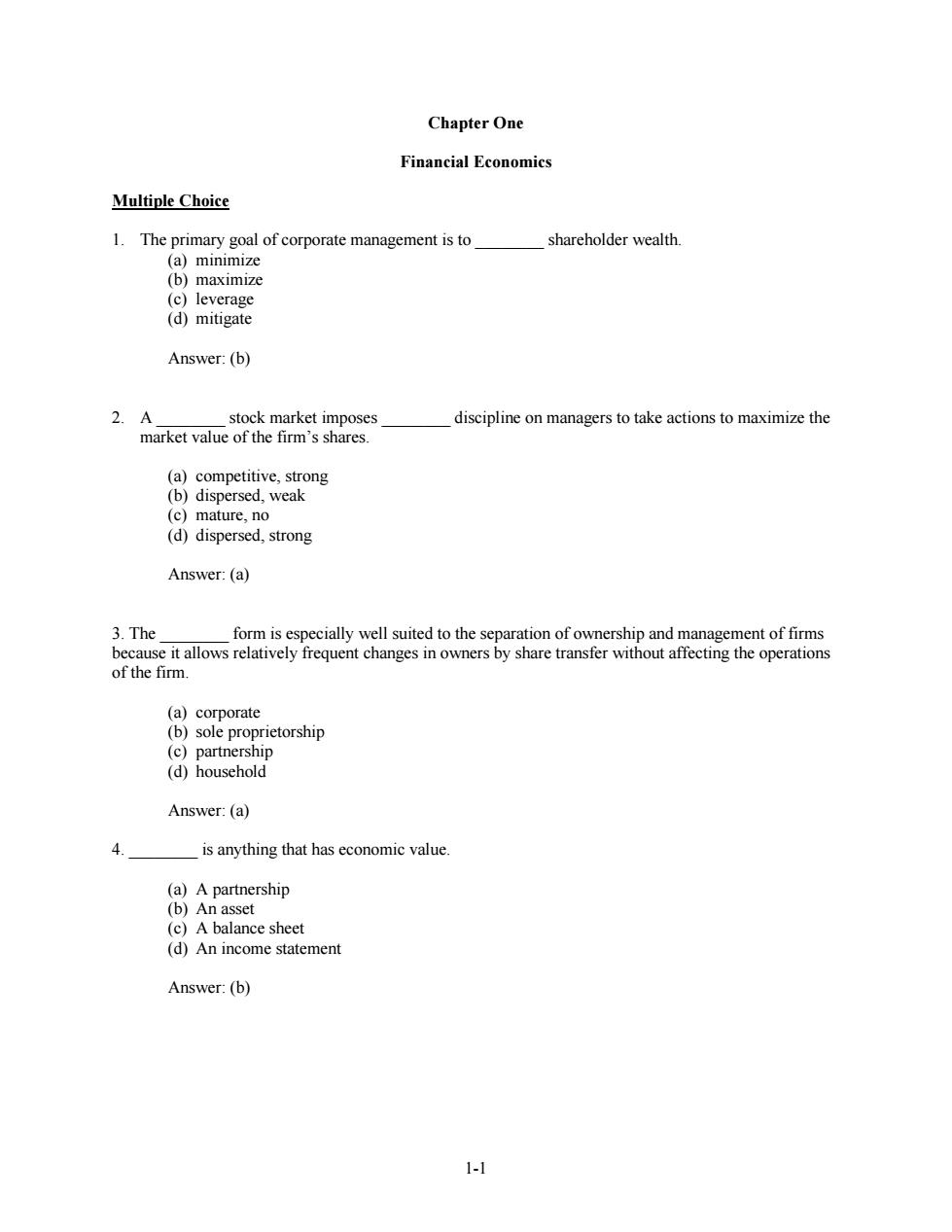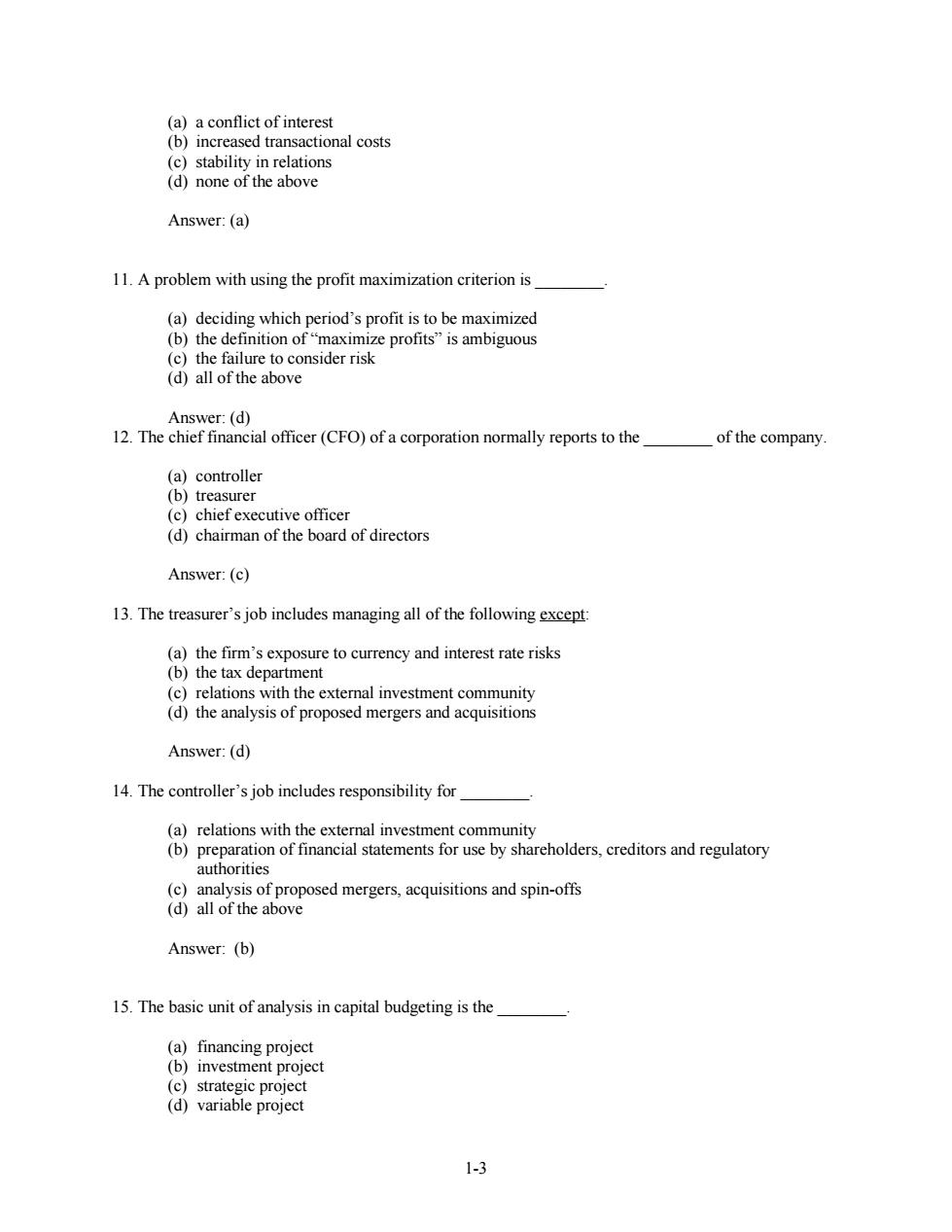
Chapter One Financial Economics Multiple Choice 1.The primary goal of corporate management is to shareholder wealth. (a)minimize (b)maximize (c)leverage (d)mitigate Answer:(b) 2.A stock market imposes discipline on managers to take actions to maximize the market value of the firm's shares (a)competitive,strong (b)dispersed,weak (c)mature,no (d)dispersed,strong Answer:(a) 3.The form is especially well suited to the separation of ownership and management of firms because it allows relatively frequent changes in owners by share transfer without affecting the operations of the firm. (a)corporate (b)sole proprietorship (c)partnership (d)household Answer:(a) 4. is anything that has economic value. (a)A partnership (b)An asset (c)A balance sheet (d)An income statement Answer:(b) 1-1
1-1 Chapter One Financial Economics Multiple Choice 1. The primary goal of corporate management is to ________ shareholder wealth. (a) minimize (b) maximize (c) leverage (d) mitigate Answer: (b) 2. A ________ stock market imposes ________ discipline on managers to take actions to maximize the market value of the firm’s shares. (a) competitive, strong (b) dispersed, weak (c) mature, no (d) dispersed, strong Answer: (a) 3. The ________ form is especially well suited to the separation of ownership and management of firms because it allows relatively frequent changes in owners by share transfer without affecting the operations of the firm. (a) corporate (b) sole proprietorship (c) partnership (d) household Answer: (a) 4. ________ is anything that has economic value. (a) A partnership (b) An asset (c) A balance sheet (d) An income statement Answer: (b)

5.A household's wealth or net worth is measured by the value of its minus its (a)liabilities;assets (b)assets;liabilities (c)stocks;bonds (d)bonds;liabilities Answer:(b) 6.The branch of finance dealing with financial decisions of firms is called or (a)investments;international finance (b)markets;institutions (c)business finance;institutions (d)business finance;corporate finance Answer:(d) 7.A disadvantage of the sole proprietorship is the fact that the sole proprietor has (a)limited liability for the debts of the firm (b)unlimited liability for the debts of the firm (c)expensive costs to establish the firm (d)limited authority over the day-to-day business decisions of the firm Answer:(b) 8.Marlowe owns a house worth $150,000,a car worth $25,000 and has an $18,000 bank account. Marlowe owes $135,000 to the bank on a home mortgage loan,$18,000 on the car loan and has an $18,000 credit card debt outstanding.Calculate Marlowe's net worth. (a)$58,000 (b)$123,000 (c)$22,000 (d)$37,000 Answer:(c) 9.An advantage of the corporate form of ownership is (a)no liability (b)unlimited liability (c)limited liability (d)CEO liability Answer:(c) 10.In the corporate form,the separated structure creates the potential for between owners and managers. 1-2
1-2 5. A household’s wealth or net worth is measured by the value of its ________ minus its ________. (a) liabilities; assets (b) assets; liabilities (c) stocks; bonds (d) bonds; liabilities Answer: (b) 6. The branch of finance dealing with financial decisions of firms is called ________ or ________. (a) investments; international finance (b) markets; institutions (c) business finance; institutions (d) business finance; corporate finance Answer: (d) 7. A disadvantage of the sole proprietorship is the fact that the sole proprietor has ________. (a) limited liability for the debts of the firm (b) unlimited liability for the debts of the firm (c) expensive costs to establish the firm (d) limited authority over the day-to-day business decisions of the firm Answer: (b) 8. Marlowe owns a house worth $150,000, a car worth $25,000 and has an $18,000 bank account. Marlowe owes $135,000 to the bank on a home mortgage loan, $18,000 on the car loan and has an $18,000 credit card debt outstanding. Calculate Marlowe’s net worth. (a) $58,000 (b) $123,000 (c) $22,000 (d) $37,000 Answer: (c) 9. An advantage of the corporate form of ownership is ________. (a) no liability (b) unlimited liability (c) limited liability (d) CEO liability Answer: (c) 10. In the corporate form, the separated structure creates the potential for ________ between owners and managers

(a)a conflict of interest (b)increased transactional costs (c)stability in relations (d)none of the above Answer:(a) 11.A problem with using the profit maximization criterion is (a)deciding which period's profit is to be maximized (b)the definition of"maximize profits"is ambiguous (c)the failure to consider risk (d)all of the above Answer:(d) 12.The chief financial officer(CFO)of a corporation normally reports to the of the company. (a)controller (b)treasurer (c)chief executive officer (d)chairman of the board of directors Answer:(c) 13.The treasurer's job includes managing all of the following except: (a)the firm's exposure to currency and interest rate risks (b)the tax department (c)relations with the external investment community (d)the analysis of proposed mergers and acquisitions Answer:(d) 14.The controller's job includes responsibility for (a)relations with the external investment community (b)preparation of financial statements for use by shareholders,creditors and regulatory authorities (c)analysis of proposed mergers,acquisitions and spin-offs (d)all of the above Answer:(b) 15.The basic unit of analysis in capital budgeting is the (a)financing project (b)investment project (c)strategic project (d)variable project 1-3
1-3 (a) a conflict of interest (b) increased transactional costs (c) stability in relations (d) none of the above Answer: (a) 11. A problem with using the profit maximization criterion is ________. (a) deciding which period’s profit is to be maximized (b) the definition of “maximize profits” is ambiguous (c) the failure to consider risk (d) all of the above Answer: (d) 12. The chief financial officer (CFO) of a corporation normally reports to the ________ of the company. (a) controller (b) treasurer (c) chief executive officer (d) chairman of the board of directors Answer: (c) 13. The treasurer’s job includes managing all of the following except: (a) the firm’s exposure to currency and interest rate risks (b) the tax department (c) relations with the external investment community (d) the analysis of proposed mergers and acquisitions Answer: (d) 14. The controller’s job includes responsibility for ________. (a) relations with the external investment community (b) preparation of financial statements for use by shareholders, creditors and regulatory authorities (c) analysis of proposed mergers, acquisitions and spin-offs (d) all of the above Answer: (b) 15. The basic unit of analysis in capital budgeting is the ________. (a) financing project (b) investment project (c) strategic project (d) variable project

Answer:(b) 16.The basic unit of analysis in capital structure decisions is the (a)firm as a whole (b)investment project (c)firm's personnel (d)financial system Answer:(a) Short Problems 1.Give a brief description of the wide range of financial instruments and claims a firm can issue. Answer:These include common stock,preferred stock,bonds and convertible securities (standardized securities that can be traded in organized markets).Financial instruments and claims can also include nonmarketable claims such as bank loans,employee stock options,leases and pension liabilities. 2.Siggy owns a house worth $200,000,a car worth $25,000 and has an $18,000 bank account.He also has furniture worth $4,000 and jewelry worth $10,000.However,Siggy owes $145,000 to the bank on a home mortgage loan,$17,000 on the car loan,$40,000 on student loans and has an $16,000 credit card debt outstanding.Calculate Siggy's net worth. Answer:Net Worth Total Assets-Total Liabilities = S200,000+S25,000+S18,000+S4,000+$10,000)- S145,000+S17,000+S40,000+816,000) =S39.000 Longer Problems 1.Describe the four basic types of financial decisions faced by householders Answer:Investment decisions-whether to invest in stocks or bonds Consumption/Savings Decisions-how much to save for one's retirement or a child's education Risk management decisions-whether to buy disability insurance Financing decisions-what type of loan to adopt in order to finance the purchase of a home or car. 2. Discuss the types of decisions that firms must make. Answer:Capital budgeting decisions-whether to build a new plant or produce a new product. Financing decisions-how much equity and how much debt a firm should adopt in its capital structure. Working Capital decisions-whether credit should be extended to a customer or cash demanded on delivery. 1-4
1-4 Answer: (b) 16. The basic unit of analysis in capital structure decisions is the ________. (a) firm as a whole (b) investment project (c) firm’s personnel (d) financial system Answer: (a) Short Problems 1. Give a brief description of the wide range of financial instruments and claims a firm can issue. Answer: These include common stock, preferred stock, bonds and convertible securities (standardized securities that can be traded in organized markets). Financial instruments and claims can also include nonmarketable claims such as bank loans, employee stock options, leases and pension liabilities. 2. Siggy owns a house worth $200,000, a car worth $25,000 and has an $18,000 bank account. He also has furniture worth $4,000 and jewelry worth $10,000. However, Siggy owes $145,000 to the bank on a home mortgage loan, $17,000 on the car loan, $40,000 on student loans and has an $16,000 credit card debt outstanding. Calculate Siggy’s net worth. Answer: Net Worth = Total Assets – Total Liabilities = ($200,000 + $25,000 + $18,000 + $4,000 + $10,000) – ($145,000 + $17,000 + $40,000 + $16,000) = $39,000 Longer Problems 1. Describe the four basic types of financial decisions faced by householders. Answer: Investment decisions – whether to invest in stocks or bonds Consumption/Savings Decisions – how much to save for one’s retirement or a child’s education Risk management decisions – whether to buy disability insurance Financing decisions – what type of loan to adopt in order to finance the purchase of a home or car. 2. Discuss the types of decisions that firms must make. Answer: Capital budgeting decisions – whether to build a new plant or produce a new product. Financing decisions – how much equity and how much debt a firm should adopt in its capital structure. Working Capital decisions – whether credit should be extended to a customer or cash demanded on delivery